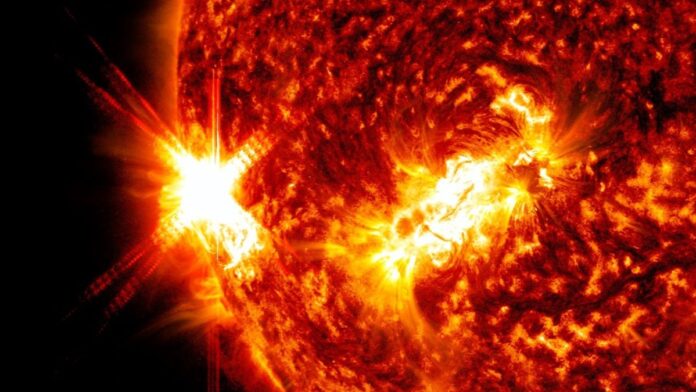A massive explosion on the sun unleashed a powerful solar flare from a new sunspot on Monday (Jan. 9), one that is slowly turning to face the Earth.
The solar flare erupted at 1:50 p.m. EST (1850 GMT) as a X1.9-class sun storm that caused a temporary, but strong, radio blackout across parts of South America, Central America and the Pacific Ocean, according to a statement (opens in new tab) from the U.S. Space Weather Prediction Center at the National Oceanic and Atmospheric Administration. X-class flares are the strongest types of storms from the sun. Monday’s flare came from the same sunspot that fired off an X1.2-class solar flare on Jan. 5, NOAA reported.
“The source is hyperactive sunspot AR3184,” astronomer Tony Phillips of the space weather website SpaceWeather.com wrote in an update (opens in new tab). “None of the debris plumes will hit Earth; the sunspot is not facing our planet. It will turn in our direction later this week.”
Related: The sun’s wrath: Here’s the worst solar storms in history
NASA captured stunning images and video of the solar flare (opens in new tab) with its Solar Dynamics Observatory, a space-based telescope that continually watches the sun in different wavelengths.
Solar flares are intense eruptions from the surface of the sun that explode at a variety of power levels. The weakest flares, classified as A-, B- or C-type storms, are typically minor. The stronger M-class flares can fling charged particles at Earth that supercharge our planet’s auroras, amplifying displays of northern lights and southern lights.
Related: Extreme solar storms can strike out of the blue. Are we prepared?
When aimed directly at Earth, X-class solar flares “can impact radio communications, electric power grids, navigation signals, and pose risks to spacecraft and astronauts,” NASA said in a statement (opens in new tab).
The sun is currently in an active phase of its 11-year weather solar cycle. The current phase is known as Solar Cycle 25, which is expected to peak in 2025.
NASA tracks solar flares and other space weather events by watching the sun with a variety of spacecraft. In addition to the Solar Dynamics Observatory, the Solar and Heliospheric Observatory or SOHO (a joint mission by NASA and the European Space Agency) also regularly watches for space weather events.
Email Tariq Malik at [email protected] (opens in new tab) or follow him @tariqjmalik (opens in new tab). Follow us @Spacedotcom (opens in new tab), Facebook (opens in new tab) and Instagram (opens in new tab).

